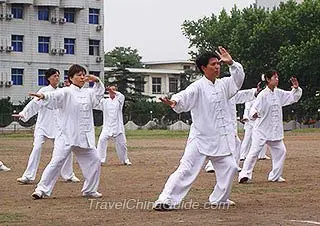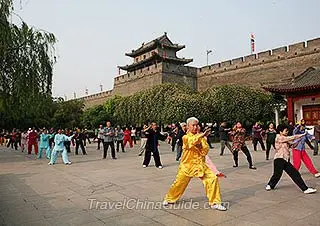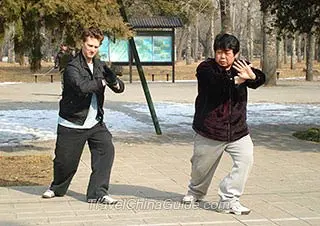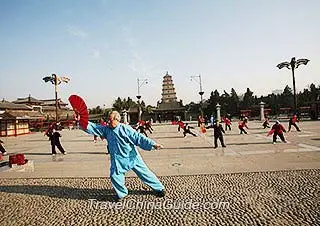Tai Chi (Taijiquan)
A Kung Fu style and sports event, Tai Chi (also known as T’ai Chi Ch’uan or Taijiquan) is a perfect combination of Chinese dialectic ideology, art and martial arts. It bears a close relation to Chinese ancient Taoism, under the guidance of which a series of practice methods were formed for learning martial arts. It is characterized by attacking, by accumulating the strength, by conquering the unyielding with the yielding skills and defeating the dynamic with the static. Moreover, this Kung Fu style is a good regimen method to cultivate shape, breath, strength, quality and spirit of the human body. Due to these distinctions, it is considered the quintessential Chinese culture.
 |
Practising Tai Chi should take two aspects into consideration: keeping the traditional elements of the thirteen movements in mind and paying attention to the physical characteristics to better guarantee fitness. Its attack styles emphasize opportunity when the weaknesses of the opponents are revealed and the strength and relative distance are appropriate. Thus it not only enhances the reaction ability as well as strength, speed and other physical qualities, but also is of great influence on the offence and defence styles.
At present, there are five major styles Tai Chi. Each of them is named after the corresponding Chinese family from which the styles originate. They are Chen Style by Chen Wangting, Yang Style by Yang Luchan, Wu Style by Wu Yuxiang, Wu Style by Wu Jianquan and Sun Style by Sun Lutang.
Chen Style
 |
Generally speaking, this style was created by Chen Wangting (1580 - 1660) who combined the ideology of Chinese traditional Yin and Yang with his ancestral Long Fist (Changquan) to create a new style. Referring to the Jingluo (the main and collateral channels in human body) of Chinese traditional medicine, he invented the five series of T’ai Chi Ch’uan, a series of Paochui Boxing, Pair Practice and other weapon series using sword, spear, staff, mace and so on. The existing Chen Style is classified into Old Frame (Laojia) and New Frame (Xinjia). The former is divided into 5 series, namely, the thirteen movements. It also includes a series of Long Fist and Paochui Boxing. The latter was created by Chen Youben. This style has something in common with the Old Frame and is different in the frequency of the attack. Generally, Chen Style is famous for the “self-twisted” of hands, feet, arms, legs and other body parts. It is considered good for body-building. Combining the breath, body and spirit, it plays well in defence by turning back, waist, even the body.
Yang Style
Yang Style was created by Yang Luchan (1800 - 1873) who loved learning martial arts in his childhood. He learned Tai Chi from Chen Changxing and cultivated his own style which was divided into Small Frame (Xiaojia) and Big Frame (Dajia). As he could flexibly avoid being attacked and attack the opponents, Yang Luchan was well-known for his own styles which were called “Soft Style” and “Melt Style”. These styles are characterized by “natural movements, continuity, and flexibility” as well as the distinctive and beautiful manner combining strength and softness. People of all ages, genders and physical conditions can choose it as a way to keep healthy and strengthen the body. As a result, Yang Style has been the most widespread and has been learned by nearly 0.3 billion people throughout the world.
Wu Style by Wu Yuxiang
 |
Created in the end of the Qing Dynasty (1644 - 1911), it belongs to the traditional Chinese Tai Chi. Different from the Chen and Yang styles, Wu Style stresses the spirit and energy. Its features are to change styles as the opponents change, to attack by the accumulated strength and to also achieve inner strength rather than the merely physical strength. It is suitable for the literates because it lays emphasis on the hands never lifting over the eyebrows, feet never reaching far out and each hand only control one half of the body. Additionally, the steps are overlapped and the feet move as if creating calligraphy.
Wu Style by Wu Jianquan
Wu Jianquan, the founder of this style, modified his ancestral Kung Fu to make it softer and more coherent. The style maintains the original skills and includes all kinds of corresponding weapons, such as Taiji Sword, Taiji Pair Swords, 13 Taiji Spears and others.
Sun Style
Based on the Wu Style by Wu Yuxiang, the Sun Style absorbs the skills of Form/Intention Boxing (Xingyiquan) of moving forward and backward with the opponents.It attaches importance to the practice of head, eyes, hands, feet, breath and willpower and the harmony of the sword and the boxing skills. The swordplay integrates the skills of raising, stirring, hanging, sweeping and others.
 |
Additionally, there are many other branches, such as Regimen Tai Chi, Wudang Tai Chi, Eight-Diagram Tai Chi, South Area Style, Wuqing Style and others. Wudang Style, combing the martial arts and fitness ideology, is beneficial to improve people’s intelligence and strengthen the physical qualities. South Area Style emphasizes the skills and the elegant shapes, while Wuqing Style focuses on the soft attack style hidden in the strength.
Due to the slow pace which is favorable to relax the nervous mentality, the Regimen Tai Chi is created to keep the fitness. In the recent years, it has been increasingly widespread because more and more people are conscious of their health. In the practice process, it emphasizes the movement of breath in order to balance the breath and blood and improve the physical functions. Therefore, it is suitable for people in different ages and with different physical conditions. Generally, six series of skills can be practiced together or respectively. The complete exercise of the 6 series including 109 gestures can be finished in 15-25 minutes.
As the social pace is accelerating, Tai Chi has been a good way for people under pressure and stress to relax. Nowadays, you can find many people practising Tai Chi in the parks or squares, such as the Temple of Heaven, Yuyuantan Park and Olympic Forest Park in Beijing, the circular City Wall Park and squares of Big Wild Goose Pagoda in Xi'an. In the morning and in the afternoon, no matter whether young or senior, male or female, amateur or professional, they gather to exercise.
